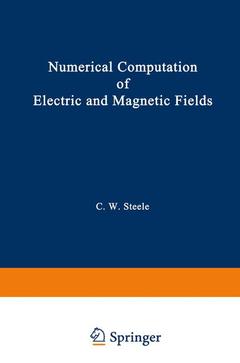Numerical Computation of Electric and Magnetic Fields, 1987
Langue : Anglais
Auteur : Steele Charles W.

For well over a decade, the numerical approach to field computation has been gaining progressively greater importance. Analytical methods of field compu tation are, at best, unable to accommodate the very wide variety of configura tions in which fields must be computed. On the other hand, numerical methods can accommodate many practical configurations that analytical methods cannot. With the advent of high-speed digital computers, numerical field computations have finally become practical. However, in order to implement numerical methods of field computation, we need algorithms, numerical methods, and mathematical tools that are largely quite different from those that have been traditionally used with analytical methods. Many of these algorithms have, in fact, been presented in the large number of papers that have been published on this subject in the last two decades. And to some of those who are already experienced in the art of numerical field computations, these papers, in addition to their own original work, are enough to give them the knowledge that they need to perform practical numerical field computations.
1. Introduction.- 2. Field Properties.- 2.1 Introduction.- 2.2 Maxwell’s Equations in the Dynamic, Quasi-Static, and Static Cases.- 2.3 Polarization and Magnetization.- 2.4 Laws for Static Fields in Unbounded Regions.- 2.5 Integral Representations for Quasi-Static Fields Using the Helmholtz Theorem.- 2.6 Equivalent Configurations.- 2.7 Steady-State Dynamic Problems and Phasor Field Representations.- 2.8 Continuity Conditions of Fields at a Medium Discontinuity.- References.- 3. Problem Definition.- 3.1 Introduction.- 3.2 Field Problem Domains, Source Problem Domains, Interior Problems, and Exterior Problems.- 3.3 Is the Problem Static, Quasi-Static, or Dynamic?.- 3.4 What Field Is To Be Computed?.- 3.5 Is the Problem Two-Dimensional or Three-Dimensional?.- 3.6 The Medium.- 3.7 Boundary Conditions.- 4. Linear Spaces in Field Computations.- 4.1 Introduction.- 4.2 Basis Functions.- 4.3 Shape Functions.- 4.4 Finite Elements and Shape Functions of Global Coordinates in Two-Dimensional Problem Domains.- 4.5 Isoparametric Shape Functions in Two Dimensions.- 4.6 Finite Elements and Shape Functions of Global Coordinates in Three-Dimensional Problem Domains.- References.- 5. Projection Methods in Field Computations.- 5.1 Introduction.- 5.2 Special Linear Spaces in Field Computations.- 5.3 Operators in Field Calculations.- 5.4 Approaches Used in Obtaining Approximate Solutions to Field Problems.- 5.5 Finite Element Method for Interior Problems.- 5.6 Integral Equation Method.- 5.7 Projection Methods.- 5.8 Orthogonal Projection Methods.- References.- 6. Finite Element Method for Interior Problems.- 6.1 Introduction.- 6.2 Formulation of Finite Element Method for Interior Problems.- 6.3 Computation of Linear System for Finite Element Method.- 6.4 Sample Problem.- References.- 7. Finite Element Method for Exterior Problems.- 7.1 Introduction.- 7.2 McDonald-Wexler Algorithm.- 7.3 Silvester et al. Algorithm.- References.- 8. Integral Equation Method.- 8.1 Introduction.- 8.2 Linear and Uniform Media in Continuity Subdomains.- 8.3 Saturable, Nonlinear, and Nonuniform Media in Continuity Subdomains.- 8.4 Numerical Solution of Integral Equations — General Approach.- 8.5 Finite Elements and Basis Functions Used in the Integral Equation Method.- 8.6 Integral Equation Numerical Solution by the Collocation Method.- 8.7 Integral Equation Numerical Solution by the Galerkin Method.- 8.8 Numerical Integration.- 8.9 Sample Problem.- References.- 9. Static Magnetic Problem.- 9.1 Introduction.- 9.2 Interior Static Field Problems.- 9.3 Exterior Static Problems Approximated by Interior Problems.- 9.4 Exterior Magnetic Static Problem.- 9.5 Static Magnetic Field in a Saturable Medium.- References.- 10. Eddy Current Problem.- 10.1 Introduction.- 10.2 Commonly Used Basic Formulations for the Eddy Current Problem.- 10.3 Simple Two-Dimensional Eddy Current Problem.- 10.4 Projection Methods for General Eddy Current Problems.- 10.5 Eddy Current Problem Formulation.- References.- Appendix A Derivation of the Helmholtz Theorem.- Appendix C Integral Expressions for Scalar Potential from Green’s Theorem.
This book presents engineers and scientists with all of the information they need to calculate electric and magnetic fields with a digital computer. It is a îcookbookî for quick field calculation, mixing mathematics, numerical analysis, and electromagnetic theory to create an easy-to-use, practical guide to static and quasi-static field problems. This new edition covers in detail the most popular, available field-computation software, dealing with the use of each and its advantages and disadvantages relative to different types of problems.
Date de parution : 05-2012
Ouvrage de 224 p.
15.2x22.9 cm
Disponible chez l'éditeur (délai d'approvisionnement : 15 jours).
Prix indicatif 52,74 €
Ajouter au panierMots-clés :
Maxwell; Potential; algorithms; computer; finite element method
© 2024 LAVOISIER S.A.S.



